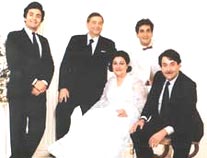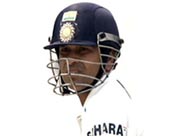Great & Famous Mathematicians of India
Brahmagupta (598 A.D. -665 A.D.) is renowned for introduction of negative numbers and operations on zero into arithmetic. His main work was Brahmasphutasiddhanta, which was a corrected version of old astronomical treatise Brahmasiddhanta. This work was later translated into Arabic as Sind Hind. He formulated the rule of three and proposed rules for the solution of quadratic and simultaneous equations. He gave the formula for the area of a cyclic quadrilateral as
After Brahmagupta, the mathematician of some consequence was Sridhara, who wrote Patiganita Sara, a book on algebra, in 750 A.D. Even Bhaskara refers to his works. After Sridhara, the most celebrated mathematician was Mahaviracharaya or.....
Mahavira. He wrote Ganita Sara Sangraha in 850 A.D., which is the first text book on arithmetic in present day form. He is the only Indian mathematician who has briefly referred to the ellipse (which he called Ayatvrit). The Greeks, by contrast, had studied conic sections in great detail.
Bhaskara (1114 A.D. -1185 A.D.) or Bhaskaracharaya is the most well known ancient Indian mathematician. He was born in 1114 A.D. at Bijjada Bida (Bijapur, Karnataka) in the Sahyadari Hills. He was the first to declare that any number divided by zero is infinity and that the sum of any number and infinity is also infinity. He is famous for his book Siddhanta Siromani (1150 A.D.). It is divided into four sections -Leelavati (a book on arithmetic), Bijaganita (algebra), Goladhayaya (chapter on sphere -celestial globe), and Grahaganita (mathematics of the planets). Leelavati contains many interesting problems and was a very popular text book. Bhaskara introduced chakrawal, or the cyclic method, to solve algebraic equations. Six centuries later, European mathematicians like Galois, Euler and Lagrange rediscovered this method and called it "inverse cyclic". Bhaskara can also be called the founder of differential calculus. He gave an example of what is now called "differential coefficient" and the basic idea of what is now called "Rolle's theorem". Unfortunately, later Indian mathematicians did not take any notice of this. Five centuries later, Newton and Leibniz developed this subject. As an astronomer, Bhaskara is renowned for his concept of Tatkalikagati (instantaneous motion).
After this period, India was repeatedly raided by muslims and other rulers and there was a lull in scientific research. Industrial revolution and Renaissance passed India by. Before Ramanujan, the only noteworthy mathematician was Sawai Jai Singh II, who founded the present city of Jaipur in 1727 A.D. This Hindu king was a great patron of mathematicians and astronomers. He is known for building observatories (Jantar Mantar) at Delhi, Jaipur, Ujjain, Varanasi and Mathura. Among the instruments he designed himself are Samrat Yantra, Ram Yantra and Jai Parkash.
Famous Indian mathematicians of the 20th century:
Srinivasa Aaiyangar Ramanujan is undoubtedly the most celebrated Indian Mathematical genius. He was born in a poor family at Erode in Tamil Nadu on December 22, 1887. Largely self taught, he feasted on Loney's Trigonometry at the age of 13, and at the age of 15, his senior friends gave him Synopsis of Elementary Results in Pure and Applied Mathematics by George Carr. He used to write his ideas and results on loose sheets. His three filled notebooks are now famous as Ramanujan's Frayed Notebooks. Though he had no qualifying degree, the University of Madras granted him a monthly scholarship of Rs. 75 in 1913. A few months earlier, he had sent a letter to great mathematician G.H. Hardy, in which he mentioned 120 theorems and formulae. Hardy and his colleague at Cambridge University, J.E. Littlewood immediately recognised his genius. Ramanujan sailed for Britain on March 17, 1914. Between 1914 and 1917, Ramanujan published 21 papers, some in collaboration with Hardy. His achievements include Hardy-Ramanujan-Littlewoo d circle method in number theory, Roger-Ramanujan's identities in partition of numbers, work on algebra of inequalities, elliptic functions, continued fractions, partial sums and products of hypergeometric series, etc. He was the second Indian to be elected Fellow of the Royal Society in February, 1918. Later that year, he became the first Indian to be elected Fellow of Trinity College, Cambridge. Ramanujan had an intimate familiarity with numbers. During an illness in England, Hardy visited Ramanujan in the hospital. When Hardy remarked that he had taken taxi number 1729, a singularly unexceptional number, Ramanujan immediately responded that this number was actually quite remarkable: it is the smallest integer that can be represented in two ways by the sum of two cubes: 1729=1³+12³=9³+10³.
Unfortunately, Ramanujan's health deteriorated due to tuberculosis, and he returnted to India in 1919. He died in Madras on April 26, 1920.
P.C. Mahalanobis : He founded the Indian Statistical Research Institute in Calcutta. In 1958, he started the National Sample Surveys which gained international fame. He died in 1972 at the age of 79.
C.R. Rao : A well known statistician, famous for his "theory of estimation"(1945). His formulae and theory include "Cramer -Rao inequality", "Fischer -Rao theorem" and "Rao - Blackwellisation".
D.R. Kaprekar (1905-1988) : Fond of numbers. Well known for "Kaprekar Constant" 6174. Take any four digit number in which all digits are not alike. Arrange its digits in descending order and subtract from it the number formed by arranging the digits in ascending order. If this process is repeated with reminders, ultimately number 6174 is obtained, which then generates itself.
Harish Chandra (1923-1983) : Greatly developed the branch of higher mathematics known as the infinite dimensional group representation theory.
Narendra Karmarkar : India born Narendra Karmarkar, working at Bell Labs USA, stunned the world in 1984 with his new algorithm to solve linear programming problems. This made the complex calculations much faster, and had immediate applications in airports, warehouses, communication networks etc.
ALL TIME GREAT MATHEMATICIANS AS KNOWN TO WORLD NOW
| ||||
| ||||
| ||||
I probably should have stopped the List at 60 or 70 names, but it's fun to keep expanding. If I were to grow the list even further here are some of the prime candidates: | ||||
| ||||













































